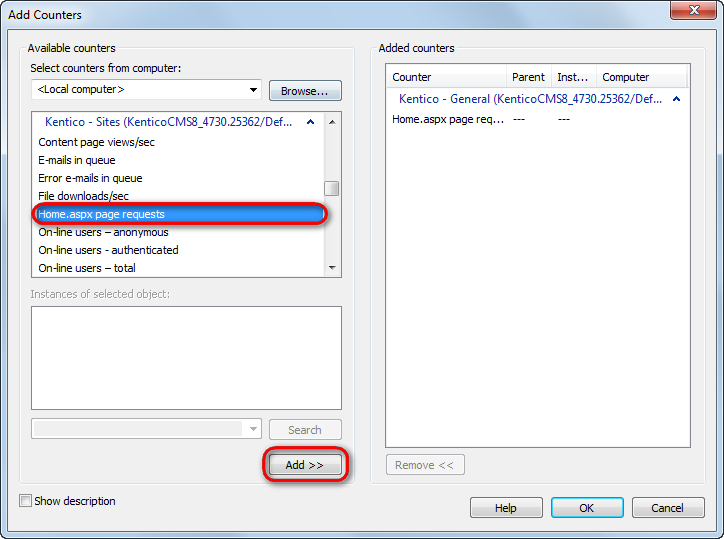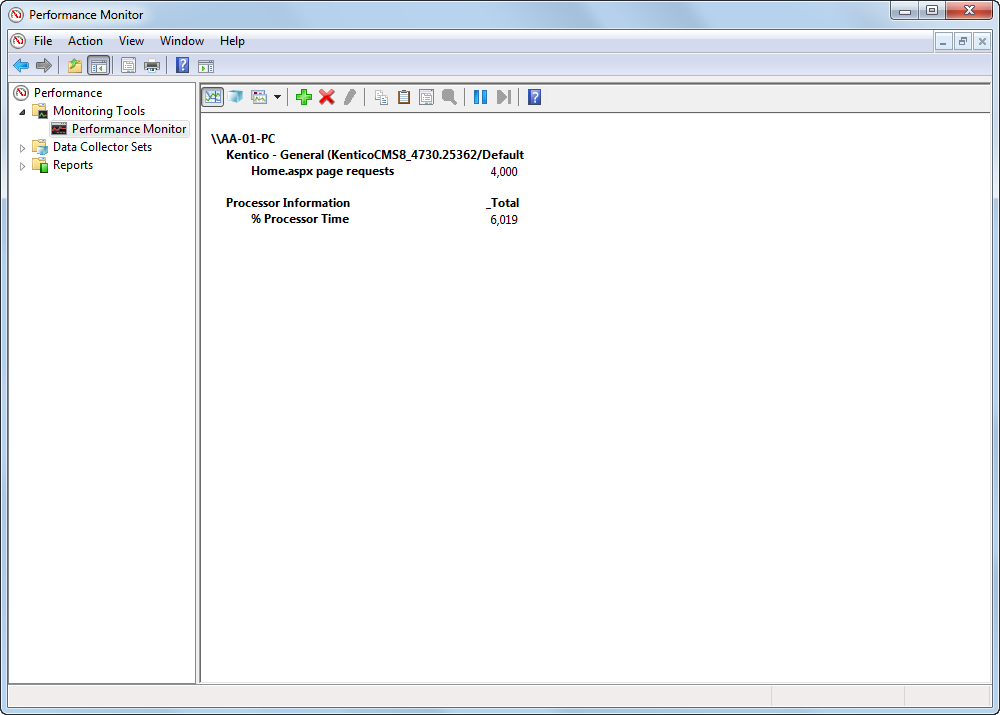Adding custom performance counters
In addition to the default performance counters, you can also implement custom performance counters to monitor other values.
The following example demonstrates how to implement a custom performance counter that monitors the number of accesses to the Home.aspx page of any website running in the system. The counter will be available in both the General and the Sites counter categories, enabling you to monitor access to the Home.aspx page of each individual website or globally for all websites in the system.
Navigate to ~\App_Data\CMSModules\HealthMonitoring folder (or any other folder under ~\App_Data\CMSModules\).
Create a new XML file with a .xpc extension, for example, MyCounters.xpc.
Copy the following code into the file:
<?xml version="1.0" encoding="utf-8"?> <Counters> <Counter Key="requestshomepage" Name="Home.aspx page requests" Description="The number of Home.aspx page requests." Type="NumberOfItems32" Enabled="True" OnlyGlobal="False" /> </Counters>Open the Kentico web project in Visual Studio.
Create a new class in App_Code (or CMSApp_AppCode -> Old_App_Code if you installed the project as a web application), for example ~\App_Code\Custom\CustomCounterModule.cs.
Extend the CMSModuleLoader partial class.
using System; using CMS.Base; using CMS.HealthMonitoring; [CustomCounterModuleLoader] public partial class CMSModuleLoader { /// <summary> /// Counter of total Home.aspx page requests. /// </summary> private static CMSPerformanceCounter mTotalHomePageRequests = null; /// <summary> /// Counter of total home page requests. /// </summary> public static CMSPerformanceCounter TotalHomePageRequests { get { if (mTotalHomePageRequests == null) { mTotalHomePageRequests = new CMSPerformanceCounter(); } return mTotalHomePageRequests; } } /// <summary> /// Attribute class for registering custom performance counters /// </summary> private class CustomCounterModuleLoaderAttribute : CMSLoaderAttribute { /// <summary> /// Runs when the application starts /// </summary> public override void Init() { // Assigns a handler to the OnLogCustomCounter event HealthMonitoringLogHelper.OnLogCustomCounter += HealthMonitoringLogHelper_OnLogCustomCounter; } private static CMSPerformanceCounter HealthMonitoringLogHelper_OnLogCustomCounter(Counter counter) { if (counter.Key.ToLower() == "requestshomepage") { return TotalHomePageRequests; } return null; } } }The private attribute mTotalHomePageRequests holds the value logged in the counter. The value is made accessible by the TotalHomePageRequests public property.
The code within the Init() method assigns the HealthMonitoringLogHelper_OnLogCustomCounter method as a handler for the OnLogCustomCounter event.
Add the OnLoad method to ~\CMSPages\PortalTemplate.aspx.cs. The code ensures that the counter value is incremented each time a page with the /home node alias path is accessed.
protected override void OnLoad(EventArgs e) { // Increments the Home.aspx page requests counter if (CMS.DocumentEngine.DocumentContext.CurrentPageInfo.NodeAliasPath.Equals("/home", StringComparison.InvariantCultureIgnoreCase)) { CMSModuleLoader.TotalHomePageRequests.Increment(CMS.SiteProvider.SiteContext.CurrentSiteName); } base.OnLoad(e); }Register counters manually by executing the Health Monitoring Windows service with the appropriate parameters, as explained in Registering performance counters.
Open the Windows command line, navigate to the Bin folder inside the Kentico installation folder (typically C:\Program Files\Kentico\<version>\Bin) and execute the HealthMonitoringService.exe file with the following parameters:
HealthMonitoringService.exe /webpath=<disk path to web project root> /createcounters
This action reloads all counters in both categories, including the newly added one.
Custom counters and Health Monitoring Windows service
Values of all custom counters can be logged only by the application itself, i.e. it is not possible for values of custom counters to be logged by the Windows service. The only purpose of using the service in this step is to register the added counter, as described in Registering performance counters.
To display the new counter values in the Performance monitor:
Make sure that the Enable health monitoring setting is enabled in Kentico (Settings -> System -> Health monitoring).
Launch the Performance monitor (type perfmon in Windows Start menu search box and press Enter).
Click Add.
- The new counter Home.aspx page requests should be present in both counter categories of the current Kentico instance.
Add the counters from both categories (General and Sites) using the Add >> button.

Click OK.
In the Kentico administration interface, open the System application and click Restart application.
Now try accessing the Home.aspx page multiple times and see how the value gets incremented after each access.
